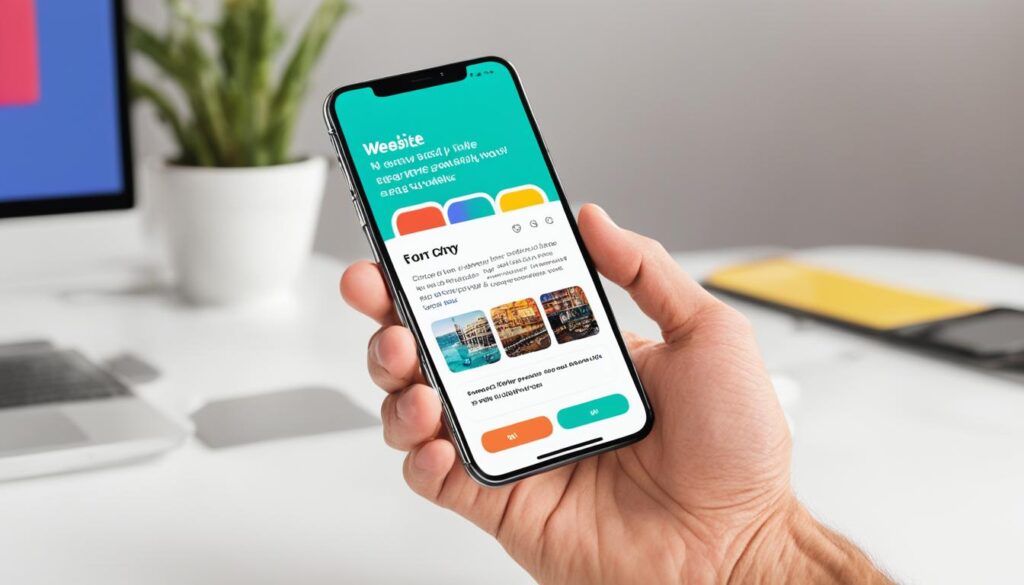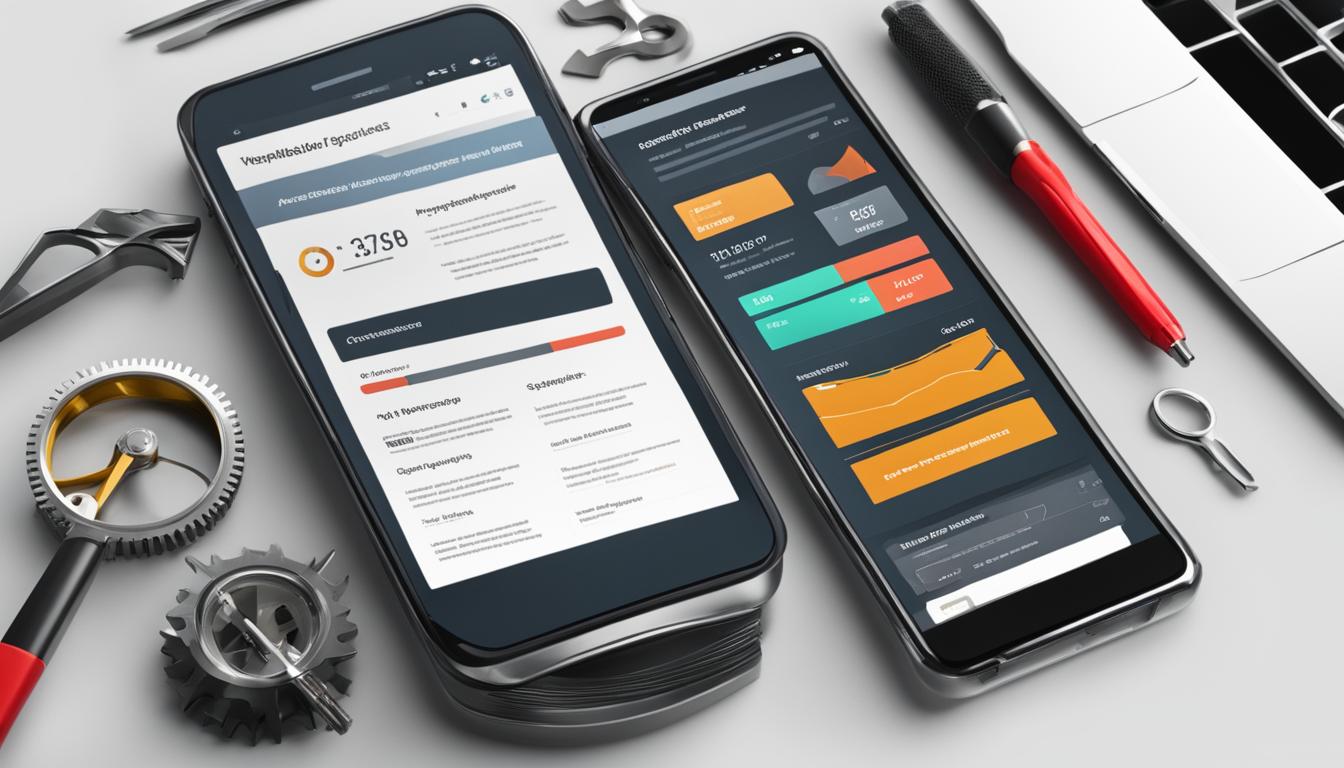In today’s digital landscape, mobile-first design is crucial for businesses aiming to capture the attention of the growing number of smartphone users. With nearly 84% of the global population owning a smartphone, mobile traffic has surpassed desktop usage, making it essential for websites to be optimized for mobile devices.
At WebsiteDesigner.Business, we understand the importance of responsive web design and prioritize mobile optimization in our services. Our expert team specializes in creating user-friendly mobile app websites that adapt seamlessly to different screen sizes, ensuring a positive user experience for your audience.
Mobile-first design focuses on creating a user-friendly interface that prioritizes mobile device performance. By adopting a mobile-first approach, businesses can enhance their online presence, attract more customers, and stay ahead of the competition.
Key Takeaways:
- Mobile-first design is crucial in today’s mobile-centric world.
- Responsive web design ensures websites adapt to different screen sizes.
- User-friendly mobile app design prioritizes mobile device performance.
- Mobile optimization attracts more customers and improves online presence.
- Choosing a reliable web design service is essential for mobile app development.
The Importance of Mobile-First Design
Mobile-first design is crucial in today’s digital landscape, where mobile devices dominate and generate a significant amount of web traffic. With over 54% of all web traffic coming from mobile devices, it is essential for websites to be optimized for mobile to reach a large number of users. Mobile-first design focuses on providing a seamless user experience on smaller screens, prioritizing fast loading times, easy navigation, and engaging content for mobile users.
By embracing mobile-first design, businesses can cater to the growing number of users accessing websites on mobile devices. This not only improves customer satisfaction and retention but also increases the likelihood of conversions and engagement. Mobile optimization is no longer a choice but a necessity to stay competitive in the market.
“Mobile-first design ensures that websites are user-friendly and provide a seamless experience on mobile devices.”
Creating a mobile-first design involves considering various factors such as responsive layouts, fluid grids, and flexible images to ensure that the website adapts well to different screen sizes. It also involves implementing mobile-friendly features like touch-friendly buttons, simplified navigation menus, and optimized content for mobile reading. By prioritizing mobile-first design, businesses can effectively capture the attention of mobile users and deliver a positive user experience.
Moreover, mobile-first design contributes to improving the overall mobile user experience (UX). By offering a user-friendly interface, fast loading times, and easy access to information, businesses can enhance user satisfaction and encourage longer interactions on their websites. This is especially important as mobile users tend to have shorter attention spans and higher expectations for convenience and efficiency.

Additionally, optimizing websites for mobile devices can have a significant impact on search engine rankings. Search engines, like Google, prioritize mobile-friendly websites in their search results, as they aim to provide the best user experience to their users. Websites that are not mobile-optimized may experience a decrease in visibility and organic traffic, potentially impacting their online presence and conversions.
By embracing mobile-first design and optimizing websites for mobile devices, businesses can tap into the vast potential of mobile traffic, enhance user experience, and stay ahead in today’s digitally-driven world.
Understanding Responsive Web Design
Responsive web design plays a crucial role in mobile-first design, ensuring that websites are visually appealing and fully functional on screens of any size. Whether users are accessing websites on smartphones, tablets, or desktops, a responsive website automatically adjusts its layout, content, and features based on the device being used. This adaptability guarantees that users have a consistent and seamless experience, no matter the screen size or device they are using.
When it comes to responsive web design, compatibility with mobile devices is a top priority. With the increasing popularity of smartphones, it is essential to create mobile-responsive websites that cater to the needs and preferences of mobile users. By designing websites that are responsive and compatible with mobile devices, businesses ensure that their content is easily accessible and enjoyable on-the-go.
A key aspect of responsive web design is scalability. Websites need to be designed in a way that allows them to scale and adapt to various screen sizes without compromising functionality or visual appeal. Scalable design ensures that the elements on a website retain their proportions and readability on both large desktop screens and smaller mobile screens. This consistency in design enhances the user experience and eliminates any frustration that may arise from a poorly optimized interface.
Implementing responsive web design requires the use of CSS (Cascading Style Sheets) and stylesheets to define and control how a website appears on different devices. By utilizing responsive design techniques, businesses can create websites that are not only aesthetically pleasing but also user-friendly and accessible across multiple devices.
“Responsive web design allows us to create a seamless user experience by adapting our websites to the needs and preferences of each individual user, regardless of the device they are using.”
Benefits of Responsive Web Design:
- Enhanced user experience across devices
- Improved mobile device compatibility
- Consistent branding and messaging
- Reduced bounce rates and increased engagement
- Higher search engine rankings and visibility

With the increasing popularity of mobile devices, responsive web design has become an essential aspect of website development. By creating mobile-responsive websites, businesses can provide a seamless user experience, increase engagement, and attract a wider audience. By understanding and implementing responsive web design principles, businesses can ensure that their websites are not only visually appealing but also fully functional and accessible on all devices.
The Shift Towards Mobile Optimization
The increasing number of users accessing the internet through smartphones has led to a significant shift towards mobile optimization. In fact, it is estimated that the number of mobile internet users will reach 3.7 billion by 2025. As businesses, we cannot afford to overlook the importance of mobile optimization in today’s digital landscape.
Mobile-friendly websites are specifically designed to provide a seamless browsing experience on smaller screens. They allow users to easily navigate and interact with the content, ensuring a user-friendly interface. With mobile traffic continuing to increase, prioritizing mobile optimization has become essential to stay competitive in the market.

Mobile usage statistics clearly highlight the dominance of smartphones in our daily lives. To cater to this mobile-first mindset, businesses must focus on creating mobile-friendly websites that deliver an exceptional user experience. By optimizing our websites for mobile devices, we can tap into the increased mobile traffic and effectively reach our target audience.
Let’s take a closer look at the shift towards mobile optimization through the following table:
| Mobile Usage Statistics: | Current Figures | Estimated Figures by 2025 |
|---|---|---|
| Number of Mobile Internet Users | 2.8 billion | 3.7 billion |
| Mobile Traffic | 54% of all web traffic | Estimated to increase further |
| Mobile Device Dominance | 84% of global population owns a smartphone | Expected to continue growing |
By optimizing our websites for mobile devices, we can tap into the increased mobile traffic and effectively reach our target audience.
As the table clearly shows, mobile usage is on the rise. Designing mobile-friendly websites is no longer an option but a necessity to cater to the needs of our mobile users. By embracing mobile optimization, we can enhance the browsing experience for our users, increase engagement, and ultimately drive better results for our business.
Best Practices for Mobile-First Web Design
Building a mobile-first website requires following best practices to ensure optimal user experience. At WebsiteDesigner.Business, we understand the importance of creating a mobile-friendly interface that caters to the needs and expectations of mobile users. Here are some key strategies and considerations to keep in mind:
- Understand your target audience: To create a mobile-friendly interface, it is essential to know your target audience. Gather customer feedback and analyze user behavior to understand their preferences, pain points, and browsing habits on mobile devices. This information will guide your design decisions and help you create a user-centric mobile experience.
- Think small: Mobile screens are smaller than desktop screens, so it’s crucial to design with limited space in mind. Prioritize the most important content and features, and avoid cluttering the interface with unnecessary elements. Streamline the user interface to provide a clean and intuitive experience for mobile users.
- Optimize website speed: Mobile users expect fast loading times and seamless navigation. Minimize large images, remove excess code, and leverage caching techniques to optimize website speed. A speedy mobile website enhances user satisfaction and reduces bounce rates.
- Refine design aesthetics: Create a visually appealing interface that aligns with your brand identity. Use appropriate colors, typography, and imagery to make your website visually engaging. Ensure that the design elements are optimized for mobile screens, maintaining readability and clarity.
- Add clear call-to-actions: Guide mobile users towards desired actions by incorporating clear and prominent call-to-actions. Whether it’s making a purchase, signing up for a newsletter, or contacting your business, clear and visible buttons or links will improve conversion rates.
- Test on real devices: Testing your mobile-first website on real devices is crucial to ensure responsiveness and performance. Use various smartphones and tablets to identify any design or functionality issues. By testing on a range of devices, you can provide a consistent experience to users across different mobile platforms.
“Designing a mobile-first website is a delicate balance of aesthetics, functionality, and user experience. By following these best practices, you can create a mobile-friendly interface that not only meets user expectations but also delivers tangible business results.”
By implementing these best practices, you can optimize your mobile-first web design, resulting in a seamless mobile user experience, increased user engagement, and improved conversions. At WebsiteDesigner.Business, we specialize in creating mobile-friendly websites that prioritize usability and visual appeal.

Embracing a Mobile-First Mindset
At [Business Name], we understand the importance of a mobile-first mindset in today’s digital landscape. To effectively reach and engage your target audience, it’s crucial to adopt a mobile optimization strategy that spans the entire customer journey.
One key aspect of embracing a mobile-first mindset is recognizing the micro-moments in which users turn to their smartphones to meet specific needs. These micro-moments are opportunities for businesses to provide relevant and tailored content that addresses the user’s intent. By understanding these moments, we can optimize our mobile websites and applications to capture the attention of our audience.
Mapping the customer journey and analyzing user behavior on different devices is essential for mobile optimization success. By monitoring how users interact with your website or app on their smartphones, you can gain valuable insights into their preferences and pain points. This data can then be used to improve the mobile user experience and drive conversions.
Creating a Personalized Mobile Experience
In today’s era of personalized marketing, it’s crucial to deliver a mobile experience that resonates with your audience on a personal level. By leveraging mobile optimization strategies, you can create an intimate connection with your users.
“By understanding the micro-moments in which users turn to their smartphones, businesses can tailor their content and CTAs to meet the user’s intent.”
Through customized messaging, personalized recommendations, and targeted offers, you can cater to the unique needs and preferences of your mobile users. This level of personalization enhances engagement and fosters a sense of loyalty towards your brand.
By adopting a mobile-first mindset, you can unlock the full potential of the mobile customer journey and leverage it to achieve your business goals. Whether it’s providing a seamless shopping experience, offering on-the-go customer support, or delivering valuable content, a mobile-first approach ensures that your brand stays relevant and accessible to your audience.

| Benefits of Embracing a Mobile-First Mindset | Mobile Optimization Strategies |
|---|---|
|
|
The Impact of Mobile Optimization on Business
Mobile optimization has become an essential factor for businesses in today’s digital landscape. With the increasing usage of mobile devices, having a mobile-friendly website is more important than ever. The benefits of mobile optimization extend beyond just providing a smooth user experience. Let’s explore how it can significantly impact your business.
Increased Conversions
A mobile-friendly website can greatly increase your conversion rates. When users find a website that is optimized for their mobile devices, they are more likely to engage with its content, stay longer, and take the desired actions. This can lead to higher conversion rates, whether it’s making a purchase, filling out a form, or subscribing to a newsletter. By optimizing your website for mobile, you create a seamless user journey that boosts conversions and drives business growth.
Improved User Experience
A positive user experience is crucial for the success of any business. Mobile optimization ensures that your website is easy to navigate, loads quickly, and provides a visually appealing interface on mobile devices. When users have a seamless and enjoyable experience with your website, they are more likely to stay engaged, explore more pages, and return in the future. By prioritizing mobile optimization, you show your customers that their satisfaction is important to you, which can lead to increased loyalty and word-of-mouth referrals.
Higher Search Engine Rankings
Search engines like Google prioritize mobile-friendly websites in their search results. Having a mobile-optimized website can improve your search engine rankings, leading to increased visibility and organic traffic. When your website ranks higher in search results, it becomes more discoverable by potential customers who are searching for products or services related to your business. By investing in mobile optimization, you not only improve user experience but also boost your online presence and reach a wider audience.
“Mobile optimization ensures that your website is easy to navigate, loads quickly, and provides a visually appealing interface on mobile devices.”
“Mobile optimization ensures that your website is easy to navigate, loads quickly, and provides a visually appealing interface on mobile devices.”
Enhanced Online Presence
A mobile-friendly website demonstrates professionalism and a commitment to meeting the needs of your customers. It sets your business apart from competitors that have not yet embraced mobile optimization. With more people accessing the internet through their mobile devices, having a mobile-friendly website is a competitive advantage that can attract and retain customers. By optimizing for mobile, you create a strong online presence that puts your business at the forefront of the digital landscape.

8 Ways to Optimize Your Website for Mobile Devices
When it comes to website optimization for mobile devices, there are several key practices that businesses can implement to ensure a mobile-friendly user experience. By following these tips, you can enhance your website’s mobile responsiveness, improve site speed, and create an intuitive browsing experience for your mobile users.
-
Test with Google’s Mobile-Friendly Tool: Use Google’s Mobile-Friendly Tool to evaluate your website’s mobile performance and identify areas for improvement. This tool highlights any issues that may affect the user experience on mobile devices, such as text readability or tap targets.
-
Focus on Website Speed: Mobile users value speed, so optimize your website to load quickly on mobile devices. Minimize file sizes, enable browser caching, and leverage content delivery networks (CDNs) to ensure fast loading times and reduce bounce rates.
-
Implement Clear Call-to-Actions: Guide users through your website by incorporating clear, actionable buttons and links. Make sure your call-to-actions are easily distinguishable and strategically placed to encourage conversions on mobile devices.
-
Create an Easy Navigation Interface: Simplify your website’s navigation for mobile users by employing intuitive menus and navigation bars. Use recognizable icons and ensure that menus are easily accessible and responsive on smaller screens.
-
Integrate with the Best Tools and Technologies: Leverage mobile-friendly design frameworks, libraries, and plugins to enhance your website’s functionality and optimize the user experience. Stay up to date with the latest tools and technologies that support mobile optimization.
-
Prioritize Website Security: Mobile users value security, so implement measures to protect their data and gain their trust. Use secure HTTPS protocols, invest in SSL certificates, and regularly update your website’s security software.
-
Minimize the Menu for a Cleaner Interface: Simplify your website’s menu structure for mobile users by condensing it into a clean and concise interface. Focus on the most essential menu items and consider collapsible menus or hidden navigation panels for a clutter-free design.
-
Add a Search Function for Easy Content Discovery: Make it easy for mobile users to find the content they’re looking for by incorporating a search function into your website. This allows users to quickly search for specific products, services, or information, improving their overall browsing experience.

By implementing these mobile-friendly design tips, you can ensure that your website is optimized for mobile devices, providing a seamless user experience and driving higher engagement and conversions. Remember, a mobile-friendly website with clear call-to-actions, easy navigation, and fast loading speed can give your business a competitive edge in today’s mobile-centric world.
Benefits of Mobile-Friendly Website and Application Design
Designing a mobile-friendly website and application offers several benefits for businesses. Mobile-friendly design improves the overall user experience, leading to increased engagement and conversions. When users can easily access and navigate a website or application on their mobile devices, they are more likely to stay and interact with the content.
Moreover, mobile-friendly design provides a competitive advantage. In today’s digital landscape, where mobile usage is dominant, users have come to expect a seamless mobile experience. Businesses that prioritize mobile-friendly platforms have a better chance of attracting and retaining customers compared to those that are not optimized for mobile.
Additionally, mobile-friendly design has a positive impact on search engine rankings. Search engines, like Google, favor websites and applications that are mobile-friendly, resulting in higher visibility and organic traffic. By embracing mobile-friendly design, businesses can enhance their online presence and stand out from the competition.
To summarize, the benefits of mobile-friendly design include:
- Improved user experience
- Increased engagement and conversions
- Competitive advantage over non-optimized platforms
- Higher search engine rankings and visibility

“By embracing mobile-friendly design, businesses can elevate their online presence and stand out from the competition.”
Making Your Website and Application Mobile Responsive
Making a website and application mobile responsive is crucial in providing an optimal user experience. We understand the importance of mobile-responsive design, mobile optimization techniques, and website testing on real devices.
Here are key steps to make your website and application mobile responsive:
- Choose a mobile-friendly theme or template: Start by selecting a responsive design that adapts to different screen sizes. This ensures that your website and application look great on all devices.
- Optimize website speed: Mobile users expect fast-loading websites. By optimizing your website’s performance, you can reduce bounce rates and provide a seamless experience.
- Implement clear call-to-actions: Guide your mobile users towards the desired actions by incorporating prominent and easy-to-use buttons or links.
- Create an easy navigation interface: Simplify the navigation menu and prioritize essential elements to enhance user experience and facilitate smooth browsing.
- Integrate with third-party tools: Leverage the power of various tools and technologies to enhance the functionality of your website and application.
- Prioritize website security: Build trust with your mobile users by ensuring that your website and application have robust security measures in place.
- Test on real devices: Use platforms like BrowserStack to test your website and application on real devices. This guarantees responsiveness and helps identify and fix any issues.
By following these mobile optimization techniques, you can create a mobile-responsive design that delivers an exceptional user experience.

Considerations for Mobile-Friendly Design
When designing a mobile-friendly website and application, there are several considerations that can greatly enhance the user experience. By taking these factors into account, businesses can create a design that meets the needs and expectations of mobile users.
Font and Size Optimization
Optimizing the font and size of your website or application is crucial for readability on smaller screens. Choosing a font that is legible and adjusting the size to be easily readable on mobile devices will ensure that users can effortlessly consume your content.
Menu Minimization
Minimizing the menu for mobile devices creates a cleaner interface and improves usability. Simplify the navigation menu by prioritizing essential options and collapsing secondary menu items. This allows users to find what they need quickly and effortlessly.
Secure Payment Gateways
Integrating secure payment gateways is vital for mobile-friendly design, particularly for e-commerce websites and applications. Instill trust in your users by offering secure payment options, protecting their sensitive information, and ensuring a smooth and secure checkout process.
Search Functionality
Consider adding a search function to your mobile-friendly design to enhance content discoverability. Users can quickly find specific information or products by entering keywords into the search bar. This feature improves navigation and user satisfaction.
Real Device Testing
Testing your website or application on real devices is essential to ensure optimal performance. Emulate real-world user experiences and identify any potential issues that may arise on specific devices or operating systems. This testing allows you to address any bugs or usability concerns.
By keeping these considerations in mind when designing your mobile-friendly website or application, you can create a seamless and user-friendly experience that caters to the needs of mobile users.
Conclusion
Mobile-first design and mobile optimization are vital for businesses in today’s mobile-centric world. With the increasing number of users accessing the internet through smartphones, it is imperative to prioritize mobile-friendly website and application design. By following best practices and considering the unique aspects of mobile user experience, businesses can improve engagement, conversions, and overall online presence.
Mobile-first design ensures that websites and applications are optimized for smaller screens, easy to navigate, and provide a seamless user experience. By embracing a mobile-first mindset and implementing mobile optimization strategies, businesses can stay ahead of the competition and effectively reach their target audience.
By investing in mobile-first design practices, businesses can create websites and applications that cater to the needs and preferences of mobile users. This not only enhances user experience but also increases the likelihood of conversions. With mobile optimization, businesses can improve their online visibility and effectively engage with their target audience. In conclusion, mobile-first design and mobile optimization are essential for businesses to thrive in the ever-evolving digital landscape.
FAQ
What is mobile-first design?
Mobile-first design is an approach to web design that prioritizes the user experience on mobile devices. It focuses on creating a user-friendly interface and optimizing performance for mobile users.
Why is mobile-first design important?
Mobile-first design is important because of the prevalence of mobile devices and the significant amount of web traffic they generate. It ensures that websites provide a seamless user experience on smaller screens and cater to the growing number of mobile users.
What is responsive web design?
Responsive web design is a crucial component of mobile-first design. It ensures that websites adapt to different screen sizes and provide a consistent user experience across devices. Responsive websites adjust their layout, content, and functionality based on the device being used.
Why is mobile optimization important?
Mobile optimization is important because an increasing number of users access the internet through smartphones. By optimizing for mobile devices, businesses can provide a seamless browsing experience, improve engagement, and attract more customers.
What are the best practices for mobile-first web design?
Best practices for mobile-first web design include focusing on the target audience, optimizing website speed, creating a user-friendly interface, and implementing clear call-to-actions. Testing the website on real devices is also essential for mobile-first design success.
How can businesses embrace a mobile-first mindset?
Businesses can embrace a mobile-first mindset by understanding the micro-moments in which users turn to their smartphones, mapping the customer journey, and analyzing user behavior on different devices. Creating a personalized and intimate mobile experience will enhance engagement and drive conversions.
What is the impact of mobile optimization on business?
Mobile optimization has a significant impact on businesses. A mobile-friendly website can lead to increased conversions, improved user experience, and higher search engine rankings. By optimizing for mobile devices, businesses can enhance their online presence and attract more customers.
How can I optimize my website for mobile devices?
To optimize your website for mobile devices, you can use Google’s Mobile-Friendly Tool to identify areas for improvement, focus on website speed, implement clear call-to-actions, create an easy navigation interface, integrate with the best tools and technologies, prioritize website security, minimize the menu, and add a search function for easy content discovery.
What are the benefits of mobile-friendly website and application design?
Mobile-friendly design improves the overall user experience, increases engagement, and provides a competitive advantage. It also improves search engine rankings and visibility. By embracing mobile-friendly design, businesses can elevate their online presence and stand out from the competition.
How can I make my website and application mobile responsive?
To make your website and application mobile responsive, you can choose a mobile-friendly theme or template, optimize website speed, implement clear call-to-actions, create an easy navigation interface, integrate secure payment gateways, and test the website and application on real devices to ensure optimal performance.
What considerations should I keep in mind for mobile-friendly design?
When designing for mobile, consider optimizing font and size for readability on smaller screens, minimizing the menu for a cleaner interface, integrating secure payment gateways, adding a search function for easy content discovery, and testing the website and application on real devices for optimal performance.

Leave a Reply